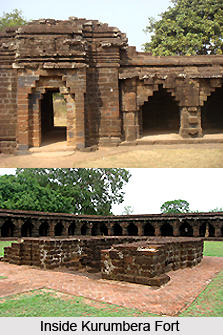 Kurumbera Fort, a medieval fort in West Bengal, is located in the Gangeshwar village to the south east of the Keshairi and is about 4 km from the village. This is an ancient fort preserved by the Archaeological Survey of India under the Ancient Monuments Act. However little is known about the people who built it or lived here. There is huge courtyard ringed by pillared corridor and in the middle there are three spherical domes. There is also some kind of an alter in the middle. The village where this located is called Gaganeshwar.
Kurumbera Fort, a medieval fort in West Bengal, is located in the Gangeshwar village to the south east of the Keshairi and is about 4 km from the village. This is an ancient fort preserved by the Archaeological Survey of India under the Ancient Monuments Act. However little is known about the people who built it or lived here. There is huge courtyard ringed by pillared corridor and in the middle there are three spherical domes. There is also some kind of an alter in the middle. The village where this located is called Gaganeshwar.
Keshairi village is situated in the Paschim Medinipur district of West Bengal. The town is small with 27 km from Kharagpur. Keshairi received huge importance when the construction for the bridge in Bhasara Ghat over Subarnarekha River enables to enter Orissa.
Even Keshiari developed its importance when it connected Belda, Bhashara Ghat and Kharapur as road junction. This road junction got connected to Ganganeshwar Village, which is known for the historical fort that is Kurumbera.
Kurumbera fort was built in the year 1438 to 1469, which is written in Oriya Inscription during the period of Kapileswar`s Deb. The structure has also built a stone inscription quoted during Aurangzeb`s era.
According to the Indian mythology, the fort was built in one night, when Lord Ram and Sita during their "Banabash" visited this place. Beside these the fort has three domes like structure on the platform along sacrificial altar. As the parts of the monuments are ruins from most of the side, the Archaeological Survey of India put efforts in order to prevent them by employing lime motar and cement in external pillars to support the fort. The roof of the pillar is flower shaped. The circular pillar on the left dome is somewhat interesting. The inscription that was stated on fort in Oriya script is now not decipherable.
The fort contains a three domed structure over a platform, along with a sacrificial altar. Though the most parts of this fort and its structures are in ruins, the Archaeological Survey of India has taken considerable effort to protect the structures from collapsing by using cement and lime mortar for holding the external pillars. The pillars hold roofing which is shaped as a flower. The usage of circular pillar to the rear of the left-dome seems interesting. The presence of an inscription stating about its usage is present right behind of the domed structure. Though the script resembles Oriya, locals state that it is not decipherable.






